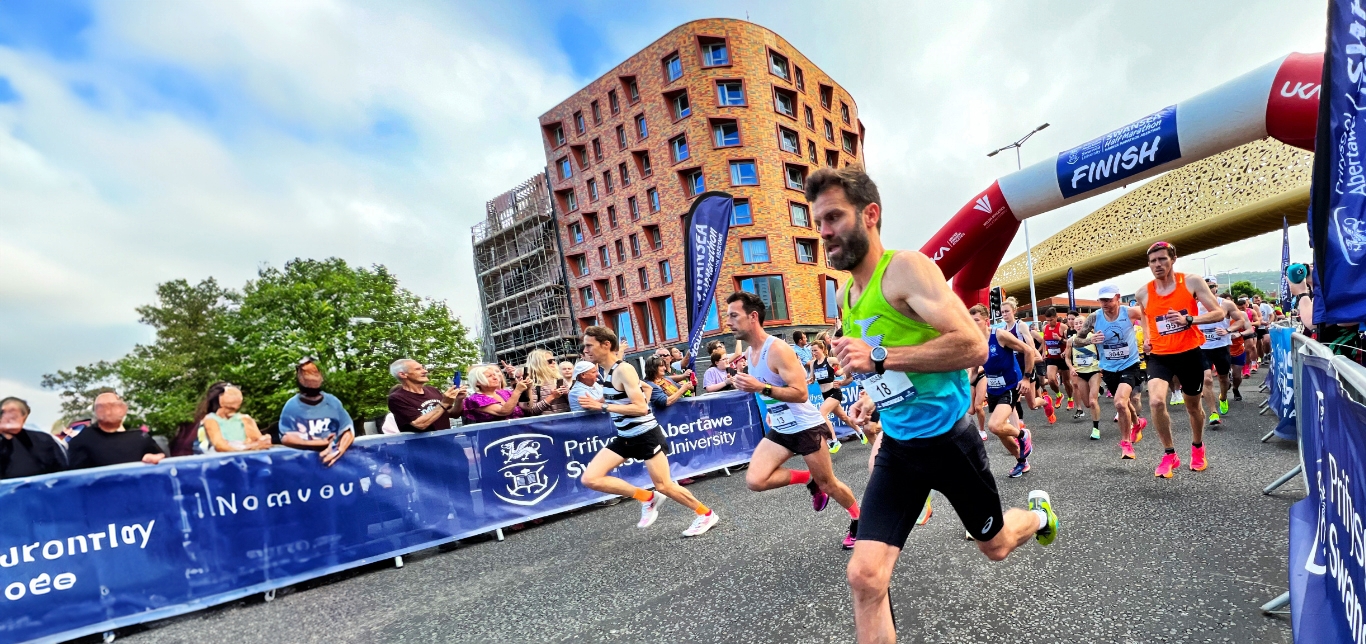

Featured
How Do I Train For A Marathon
Modified: January 22, 2024
Learn how to train for a marathon with our featured guide. Discover essential tips, techniques, and plans to help you conquer the distance and achieve your running goals.
Introduction
Are you thinking about taking on the challenge of running a marathon? Congratulations! Training for a marathon is a rewarding and transformative experience that pushes your physical and mental limits. Whether you’re a seasoned runner or a newbie to the sport, embarking on this journey requires careful planning and preparation. In this article, we will guide you through the essential steps to effectively train for a marathon.
Running a marathon is more than just a race; it’s a personal journey that tests your endurance, discipline, and determination. Crossing that finish line after 26.2 miles is an accomplishment that only a dedicated few can claim. However, proper training is the key to achieving this goal safely and successfully.
Before diving into the details of marathon training, it’s important to note that preparation should begin several months in advance. Building a solid foundation of endurance, increasing mileage gradually, and incorporating strength and speed training are all crucial aspects of your overall training plan.
Throughout the training process, it’s essential to listen to your body and make adjustments as needed. Remember, everyone’s journey is unique, and it’s important to tailor your training to your individual capabilities and goals.
In the following sections, we will explore setting goals, creating a training schedule, building endurance, incorporating speed and interval training, performing strengthening exercises, maintaining proper nutrition and hydration, understanding the importance of rest and recovery, mentally preparing yourself for the marathon, and avoiding common mistakes. Each of these elements plays a vital role in your overall training plan and will contribute to your success on race day.
So, lace up your shoes, get ready to sweat, and let’s dive into the world of marathon training. Remember, the journey may be challenging, but the sense of accomplishment you’ll feel when you complete that marathon will make it all worthwhile.
Setting Goals
Before you begin your marathon training, it’s important to establish clear and realistic goals. Setting goals provides you with direction and motivation throughout the training process. Whether it’s completing your first marathon, improving your personal best, or simply finishing strong, your goals will shape your training plan and guide your progress.
When setting goals, it’s crucial to consider your current fitness level, previous running experience, and time commitment. Be honest with yourself about what you can realistically achieve within the given timeframe.
Start by determining your target finish time or the specific outcome you want to achieve. This will serve as a benchmark to evaluate your progress and adjust your training. Remember, marathon training is a gradual process that requires a steady increase in mileage and intensity. Setting incremental goals along the way will keep you motivated and prevent burnout.
Additionally, consider setting both short-term and long-term goals. Short-term goals can be weekly or monthly milestones, such as increasing your long run distance or improving your pace on shorter runs. Long-term goals, on the other hand, should align with your ultimate objective for the marathon. For example, completing a half marathon as a stepping stone or gradually increasing your weekly mileage.
When setting goals, make sure they are specific, measurable, attainable, relevant, and time-bound (SMART goals). This approach ensures that your goals are clear, realistic, and have a specific timeline. For example, instead of saying, “I want to run a marathon,” a SMART goal would be, “I want to finish the marathon in under 4 hours by following a 16-week training plan.”
Lastly, remember that flexibility is key when it comes to goal-setting. Don’t be afraid to adjust your goals as you progress through your training. Your body may respond differently to the training stimulus, and unexpected circumstances may arise. Stay adaptable and be open to modifying your goals as needed.
By setting clear, achievable, and flexible goals, you will establish a roadmap for your marathon training journey. These goals will keep you motivated, track your progress, and ultimately guide you towards crossing that finish line with a sense of accomplishment.
Creating a Training Schedule
One of the most critical aspects of marathon training is creating a structured and well-balanced training schedule. A well-designed training schedule helps you stay organized, ensures that you gradually build endurance, and minimizes the risk of injury.
When creating your training schedule, consider your current fitness level, time commitment, and any other commitments you may have outside of running. It’s important to find a balance that challenges you without overwhelming your body or compromising other areas of your life.
First, determine the length of your training program. The typical marathon training program ranges from 12 to 20 weeks, depending on your experience and fitness level. Beginners may opt for a longer program to allow for a slower progression, while more seasoned runners may choose a shorter program.
Next, establish a weekly mileage target that gradually increases over the course of your training. It’s important to build up your endurance gradually to prevent overuse injuries. Aim to increase your weekly mileage by no more than 10% each week.
Now, let’s break down the weekly schedule. Start by designating your long run day, usually on the weekends. This run will be the cornerstone of your weekly mileage and should gradually increase in distance as the weeks progress. Long runs help build both physical and mental endurance, as they simulate the challenge of running for an extended period.
In addition to the long run, include three to four shorter runs during the week. These runs can vary in distance and intensity, focusing on different aspects of your training, such as speed, tempo, or recovery. Incorporate a mix of easy runs, intervals, and tempo runs to improve your strength and overall performance.
It’s also essential to incorporate cross-training activities into your schedule. Cross-training provides a break from running while still enhancing your cardiovascular fitness and strengthening complementary muscle groups. Activities such as swimming, cycling, or strength training can be used to supplement your running program.
Rest days are just as important as training days. Allow yourself at least one or two rest days per week to recover and prevent overtraining. Rest days give your muscles a chance to repair and rebuild, reducing the risk of injury and promoting optimal performance.
As you progress through your training, be prepared to adjust your schedule based on your body’s response. Listen to any signs of fatigue or injury and make necessary modifications. Flexibility and adaptability are key to a successful training program.
Remember, a well-structured training schedule sets the foundation for your marathon success. It provides a blueprint for progression, balance, and recovery, ensuring that you’re adequately prepared for the demands of race day.
Building Endurance
Building endurance is a crucial component of marathon training. Endurance is the ability to maintain a steady pace over a prolonged period, and it plays a vital role in completing a marathon successfully. By gradually increasing your mileage and incorporating strategic training techniques, you can improve your endurance and prepare your body for the demands of the marathon.
One of the most effective ways to build endurance is to increase your weekly mileage gradually. As mentioned earlier, aim to increase your mileage by no more than 10% each week. This gradual progression allows your muscles, joints, and cardiovascular system to adapt and become more efficient at utilizing oxygen.
In addition to increasing mileage, long runs are an essential component of building endurance. These runs should be slower in pace than your shorter training runs, allowing you to sustain your energy over a longer period. Start with a comfortable distance and gradually increase it on a weekly basis. The long run should eventually reach a distance slightly longer than the full marathon to provide mental and physical preparation.
Another effective technique for building endurance is the practice of running at a conversational pace. This means running at a pace where you can comfortably carry on a conversation. By doing so, you are training your body to utilize fat as a fuel source and improving your aerobic capacity.
Hill training is another valuable tool for building endurance. Incorporating hill repeats into your training helps to strengthen your muscles, improve stride length, and increase cardiovascular fitness. Find a challenging hill and run up it at a moderate effort, then jog or walk back down to recover. Repeat this process several times, gradually increasing the number of repeats as your fitness improves.
Interval training is another technique that can help boost your endurance. By incorporating interval sessions into your training, you alternate between high-intensity efforts and recovery periods. For example, you could run at a faster pace for 1-2 minutes, followed by a slower jog or walk for 1-2 minutes. This type of training challenges your cardiovascular system, improves your lactate threshold, and enhances your overall endurance.
Consistency is key when it comes to building endurance. While it’s important to push yourself during training, it’s equally important to listen to your body and allow for proper recovery. Recovery days and rest periods are crucial for your muscles to repair and adapt to the stress of training.
Building endurance takes time and patience. Be diligent with your training, stay consistent, and trust in the process. Gradually increasing mileage, incorporating long runs, practicing conversational pace running, hill training, and interval sessions will all contribute to improving your endurance and ultimately helping you conquer the marathon distance.
Speed and Interval Training
Speed and interval training are critical components of marathon preparation that help improve your overall performance and increase your running efficiency. These training techniques focus on increasing your speed, boosting your anaerobic threshold, and enhancing your ability to maintain a faster pace for longer periods.
One common form of speed training is the tempo run. Tempo runs involve running at a comfortably hard pace, just below your lactate threshold. This pace is challenging but still allows you to sustain the effort. Start with a shorter distance, such as 1-2 miles, and gradually increase it as your fitness improves. Tempo runs help develop your aerobic capacity and teach your body to maintain a faster pace over a sustained period.
Interval training involves alternating between high-intensity efforts and recovery periods. These high-intensity intervals push your body’s limits and increase your anaerobic capacity. For instance, you can incorporate 400-meter or 800-meter repeats at a faster pace than your normal running speed, followed by a period of active recovery (typically a slower jog or walk). Repeat this cycle for several sets to challenge your cardiovascular system and improve your speed.
Fartlek training is another effective method for incorporating speed work into your training regimen. Fartlek, which means “speed play” in Swedish, involves alternating between fast bursts of running and slower recovery periods. This form of training is less structured than interval training and allows you to vary your pace and terrain. You can incorporate fartlek training during one of your regular runs by randomly selecting landmarks or objects to sprint towards, followed by a period of slower running or walking to recover.
Track workouts are an excellent way to focus on specific speed and interval training. Utilize a local track to perform workouts such as 200-meter or 400-meter repeats at a challenging pace, with a recovery period in between. These sessions help improve your running economy, increase your leg turnover rate, and enhance your anaerobic capacity.
It’s important to note that speed and interval training can be intense on the body, so it’s crucial to incorporate these workouts gradually and to allow for adequate recovery afterward. Start with one or two speed sessions per week and gradually increase the intensity as your body adapts.
Remember to always warm up before speed and interval workouts to prepare your muscles and prevent injury. Cooling down and stretching after these sessions also aids in recovery and reduces muscle soreness.
Incorporating speed and interval training into your marathon preparation will not only improve your running performance but also enhance your overall endurance and mental toughness. These workouts challenge your body and push your limits, preparing you to maintain a faster pace on race day.
Strengthening Exercises
When training for a marathon, don’t overlook the importance of incorporating strengthening exercises into your routine. Strong muscles provide stability, improve running form, and help prevent injuries. By incorporating specific strength exercises into your training program, you can enhance your overall performance and build a resilient body capable of tackling the marathon distance.
One of the key areas to focus on is the core. A strong core stabilizes your body and enhances your running posture, leading to improved efficiency and reduced fatigue. Exercises such as planks, Russian twists, and bicycle crunches target the abdominal muscles, obliques, and lower back. Aim to include a variety of core exercises in your routine, focusing on both strength and stability.
Another important muscle group to strengthen is the lower body. Strong leg muscles provide power and stability during running. Incorporate exercises such as squats, lunges, and calf raises to target the quadriceps, hamstrings, glutes, and calves. These exercises help improve leg strength, enhance stride length, and prevent muscle imbalances.
Don’t forget to include exercises that target the upper body as well. While running primarily engages the lower body, having a strong upper body contributes to overall balance and running efficiency. Push-ups, shoulder presses, and rows are excellent exercises to strengthen your arms, shoulders, and upper back. A strong upper body also helps maintain proper arm swing and posture throughout your run.
In addition to targeted strength exercises, it’s important to include functional movements and exercises that mimic the demands of running. Exercises such as step-ups, lateral lunges, and single-leg squats improve balance, stability, and coordination. These functional exercises train the smaller stabilizer muscles and help prevent common running injuries.
When implementing a strength training routine, consider your time commitment and schedule. Aim to perform strength exercises 2-3 times per week, focusing on different muscle groups each session. Allow for proper rest and recovery between workouts to allow your muscles to repair and adapt.
Remember to always maintain proper form during strength exercises to avoid injury. Start with light weights or bodyweight exercises and gradually increase the intensity as your strength improves. If you’re new to strength training, consider working with a qualified trainer to ensure you’re using correct form and to create a tailored program to your needs.
Incorporating strengthening exercises into your marathon training routine will improve your overall muscular strength and endurance, enhance your running form, and reduce the risk of injuries. By building a strong foundation, you’ll be better equipped to tackle the physical demands of the marathon and optimize your performance on race day.
Proper Nutrition and Hydration
Proper nutrition and hydration are vital components of marathon training. Fueling your body with the right nutrients and maintaining optimal hydration levels are key to sustaining energy, promoting recovery, and enhancing performance. Implementing a well-balanced diet and establishing a hydration strategy will help you stay strong and fueled throughout your training and on race day.
When it comes to nutrition, focus on consuming a variety of nutrient-dense foods that provide the necessary carbohydrates, proteins, and fats to support your training. Carbohydrates are particularly important as they serve as the primary fuel source for endurance exercise. Include whole grains, fruits, vegetables, and legumes in your diet to ensure an adequate intake of complex carbohydrates.
Proteins are essential for muscle repair and recovery. Ensure you’re consuming lean sources of protein such as lean meats, fish, poultry, tofu, and legumes to support muscle development. Fats, including healthy sources like avocados, nuts, and olive oil, provide energy and aid in nutrient absorption.
Timing your meals and snacks appropriately is also crucial. Eat a balanced meal containing carbohydrates, protein, and healthy fats 2-3 hours before a long run or intense workout to provide sustained energy. For shorter runs or workouts, a light snack 30-60 minutes beforehand should be sufficient. After exercise, replenish your glycogen stores and provide protein for muscle repair by consuming a post-workout meal or snack within 30-60 minutes.
Hydration is equally important for performance and recovery. Dehydration can lead to fatigue, decreased performance, and increased risk of injury. Hydrate throughout the day by consuming water and electrolyte-rich beverages. When it comes to fluids during exercise, aim to consume 4-8 ounces of fluid every 15-20 minutes, adjusting based on factors like sweat rate and weather conditions.
Electrolytes, such as sodium, potassium, and magnesium, play a crucial role in maintaining fluid balance and muscle function. Include foods rich in these electrolytes, such as bananas, spinach, and nuts, in your diet. For longer runs or intense workouts lasting over an hour, consider replenishing electrolytes through sports drinks or electrolyte tablets.
Remember to listen to your body’s cues for hunger and thirst. Each individual’s needs may vary, so it’s important to pay attention to how you feel and make adjustments accordingly. Consult with a registered dietitian or sports nutritionist for personalized recommendations if needed.
In your marathon training, proper nutrition and hydration should be viewed as integral parts of your overall strategy. By fueling your body with the right nutrients and maintaining optimal hydration, you’ll support your training, enhance your performance, and help prevent fatigue and injury, ultimately maximizing your potential on race day.
Rest and Recovery
Rest and recovery are often overlooked but are crucial components of effective marathon training. Taking time to allow your body to rest and recover is essential in preventing overtraining, reducing the risk of injury, and maximizing your performance on race day.
During training, your body undergoes a significant amount of stress and strain. Rest days provide an opportunity for muscles, tendons, and ligaments to repair and rebuild, preventing overuse injuries. Schedule at least one or two rest days per week, where you engage in activities that promote relaxation and rejuvenation.
Sleep is a vital aspect of rest and recovery. Aim for 7-9 hours of quality sleep per night, as it plays a crucial role in tissue repair, hormone regulation, and overall recovery. Prioritize establishing a regular sleep schedule and creating a sleep-friendly environment, ensuring that your body receives the rest it needs to perform optimally.
Active recovery is another valuable strategy to incorporate into your training program. Instead of complete rest, engage in low-intensity activities such as swimming, cycling, or yoga on your rest days. These gentle movements promote blood flow, aid in the removal of metabolic waste, and can help reduce muscle soreness.
Massage and foam rolling are effective techniques for aiding in recovery. Massage helps improve circulation, releases tension in tight muscles, and promotes relaxation. Foam rolling, on the other hand, is a self-massage technique that targets myofascial release. It can help alleviate muscle tightness and improve flexibility.
Proper nutrition and hydration also contribute to recovery. Ensure you’re consuming a balanced diet that includes essential nutrients for muscle repair and replenishing glycogen stores. Adequate hydration aids in the removal of metabolic waste and supports cellular function.
Active rest and cross-training activities, such as swimming or cycling, can complement your marathon training by providing a break from running while still maintaining cardiovascular fitness and engaging different muscle groups.
Mental rest is just as important as physical rest. Dedicate time to activities that help calm your mind, such as mindfulness, meditation, or engaging in hobbies you enjoy. Mental rest reduces stress levels and aids in mental focus and motivation.
Remember, rest and recovery are not signs of weakness or laziness; they are essential components of an effective training plan. Embrace rest days as an opportunity to recharge, heal, and come back stronger for your next training session. Listen to your body, and don’t hesitate to adjust your training plan if you feel excessively fatigued or notice signs of overtraining.
By prioritizing rest and recovery, you allow your body to adapt and respond to the physical demands of marathon training. This approach ensures that you are well-prepared, mentally and physically, to tackle the challenges of race day and achieve your goals.
Mental Preparation
While marathon training is physically demanding, it’s crucial not to neglect the mental aspect of preparation. Mental strength and resilience play a significant role in overcoming challenges, staying motivated, and maintaining focus throughout your training and on race day. Here are some strategies for mental preparation:
Visualize success: Visualizing yourself crossing the finish line, feeling strong, and achieving your goals can have a powerful impact on your mindset. Take the time to imagine yourself running the marathon smoothly and confidently, overcoming any obstacles along the way. This mental imagery can help build confidence and set a positive tone for your training.
Set process-oriented goals: While it’s important to have specific outcome goals, such as finishing within a certain time, it’s equally important to set process-oriented goals. These goals focus on the steps and behaviors needed to achieve your desired outcome. For example, setting a goal to stick to your training schedule, complete each long run, or maintain a consistent pace during your tempo runs. By focusing on the process, you’ll stay motivated and build a sense of accomplishment along the way.
Practice mental toughness: Running a marathon is a physical and mental challenge. Training your mind to stay strong and resilient is just as important as training your body. During your training runs, practice pushing through discomfort, maintaining focus, and staying positive when faced with fatigue or adversity. Developing mental toughness will help you overcome tough moments during the marathon and keep you motivated to reach the finish line.
Develop positive self-talk: The way you talk to yourself during training and on race day can significantly impact your performance. Practice positive self-talk by replacing negative or self-doubting thoughts with encouraging and empowering ones. Instead of saying “I can’t do this,” remind yourself that you are strong, capable, and prepared for the challenges ahead. Incorporate positive affirmations into your training routine to boost your self-confidence.
Seek support: Having a support system can provide motivation, encouragement, and accountability throughout your training. Surround yourself with people who believe in your goals and are there to support you along the way. Join a running group, find a training partner, or reach out to online communities to connect with fellow runners. Sharing your journey and experiences can provide valuable support and help keep you motivated.
Practice mindfulness and relaxation techniques: Running a marathon can be mentally taxing. Incorporating mindfulness and relaxation techniques into your routine can help reduce stress and improve focus. Engage in activities such as meditation, deep breathing exercises, or yoga to quiet the mind, reduce anxiety, and enhance mental clarity.
Remember to enjoy the journey: Training for a marathon is a challenging endeavor, but it’s also an incredible opportunity for personal growth and discovery. Embrace the process, celebrate your progress, and find joy in the journey. Remind yourself why you embarked on this adventure and reflect on the positive changes that running has brought to your life.
By incorporating mental preparation into your training, you’ll develop the mental fortitude and resilience needed to overcome obstacles, stay motivated, and maintain focus on race day. Building a strong mental foundation will ensure that you’re prepared to tackle the physical and mental challenges of running a marathon.
Avoiding Common Mistakes
When training for a marathon, it’s important to be aware of common mistakes that can hinder your progress and increase the risk of injury. By understanding these pitfalls and taking proactive steps to avoid them, you can set yourself up for a successful and rewarding marathon experience. Here are some common mistakes to avoid:
Skipping proper warm-up and cool-down: Neglecting to warm up before a run and cool down afterward increases the risk of injury. Take a few minutes to perform dynamic stretches and light exercises to warm up your muscles before heading out on your run. Similarly, allow time for a proper cool-down, including static stretching, to aid in recovery and prevent muscle tightness.
Increasing mileage too quickly: Gradual progression is key in marathon training. Increasing mileage too rapidly can lead to overuse injuries such as stress fractures or tendonitis. Stick to the 10% rule, which advises increasing your weekly mileage by no more than 10% from one week to the next.
Neglecting cross-training and strength exercises: Running alone is not sufficient for overall fitness and injury prevention. Incorporating cross-training activities and strength exercises into your routine helps build strength in complementary muscle groups and reduces the risk of overuse injuries. Incorporate activities like swimming, cycling, or strength training to maintain balance and support your running performance.
Ignoring rest days: Rest is crucial for allowing your body to recover and adapt to the physical stress of training. Pushing through fatigue, skipping rest days, or overtraining can lead to burnout, decreased performance, and an increased risk of injury. Give your body time to rest and rejuvenate, allowing for proper recovery between workouts.
Not listening to your body: Pay attention to signs of fatigue, pain, or discomfort during training. Ignoring these cues and pushing through can lead to injury. Be mindful of any unusual aches or pains and seek medical attention if necessary. It’s better to take a short break or modify your training than to risk a more significant setback due to injury.
Neglecting proper nutrition and hydration: Fuelling your body with the right nutrients and maintaining proper hydration levels is critical for optimal performance and recovery. Neglecting nutrition and hydration can lead to decreased energy levels, impaired recovery, and poor performance. Prioritize healthy, balanced meals and drink enough fluids throughout the day, especially during long runs.
Comparing yourself to others: Every runner is on their own unique journey. Comparing your progress or performance to others can lead to self-doubt and unnecessary pressure. Focus on your individual goals, celebrate your achievements, and trust in your training plan.
Not tapering before race day: Tapering refers to reducing training volume and intensity in the weeks leading up to the marathon. Some runners make the mistake of continuing intense training until the last minute, which can lead to fatigue and decreased performance on race day. Follow a proper tapering plan to allow your body to recover and be fresh for the marathon.
By avoiding these common mistakes and adopting smart training practices, you can significantly improve your marathon experience. Remember that consistency, listening to your body, maintaining balance, and prioritizing recovery will set the stage for a successful and enjoyable marathon journey.
Conclusion
Training for a marathon is a challenging yet rewarding journey that requires dedication, discipline, and perseverance. By following the guidelines and strategies outlined in this article, you can set yourself up for success and have a fulfilling marathon experience.
Setting clear goals, creating a well-structured training schedule, building endurance, incorporating speed and interval training, engaging in strengthening exercises, maintaining proper nutrition and hydration, prioritizing rest and recovery, and preparing yourself mentally are all essential aspects of effective marathon training.
Remember, marathon training is a gradual process that requires patience and consistency. Listen to your body, make adjustments as needed, and allow yourself adequate time to recover and adapt to the demands of training. Take care of your physical health by nourishing your body with the right nutrients, hydrating properly, and incorporating strength and cross-training exercises.
Equally important is the mental aspect of training. Cultivate a positive mindset, practice mental toughness, visualize success, and seek support from your community. Understand that there will be challenges along the way, but with mental fortitude and resilience, you can overcome them.
Avoid common training mistakes and prioritize rest and recovery. Give your body and mind the time they need to rejuvenate and prepare for the physical and mental demands of race day.
Lastly, enjoy the journey. Training for a marathon is an incredible opportunity for personal growth and self-discovery. Embrace the process, celebrate your progress, and find joy in the milestones achieved along the way.
As you cross that finish line on race day, you’ll experience an overwhelming sense of accomplishment and exhilaration—a testament to your hard work and dedication. The marathon journey will leave an indelible mark on your life, empowering you with a sense of resilience, determination, and the knowledge that you can overcome any challenge that comes your way.









